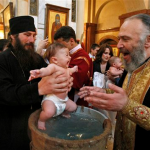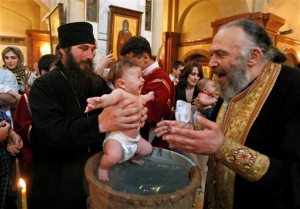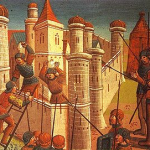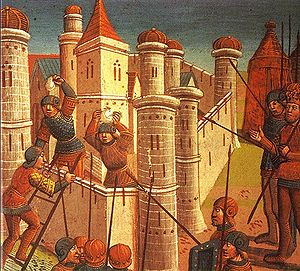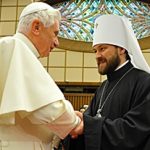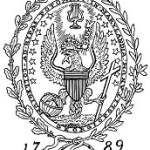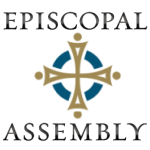Deprecated: trim(): Passing null to parameter #1 ($string) of type string is deprecated in
/home/aoiusa/public_html/wp-content/plugins/sexybookmarks/public.php on line
388
Deprecated: trim(): Passing null to parameter #1 ($string) of type string is deprecated in
/home/aoiusa/public_html/wp-content/plugins/sexybookmarks/public.php on line
394
Deprecated: trim(): Passing null to parameter #1 ($string) of type string is deprecated in
/home/aoiusa/public_html/wp-content/plugins/sexybookmarks/public.php on line
400
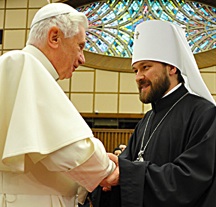
Pope Benedict meets Abp. Hilarion in Rome
– Source:
Crisis Magazine | Joseph Susanka
A year and a half ago, while searching for a recording of Bach’s Matthäus-Passion to share with a friend, I stumbled across a YouTube clip entitled simply: ”St Matthew Passion. No. 1.”
Filled with idle musical curiosity, I clicked away, and within moments, realized that I had discovered something extraordinary. This was breathtaking music; grandiose, yet restrained; a piece that spoke more eloquently of the sorrow and hope of Christ’s suffering than anything I’d experienced since hearing Bach’s own Matthäus-Passion for the first time. Yet despite the obvious influences of Leipzig’s Capellmeister, the piece’s sombre Russian sensibilities were equally unmistakable. Who was this composer? And why had it taken me so long to discover his work?
A bit of research revealed an answer as unexpected as was my initial (lucky) discovery: this astonishing work was written barely five years ago. And its creator, despite producing some of the most beautiful, traditionally-influenced sacred music I’ve had the pleasure to discover, isn’t even a “full-time composer.” He’s a bishop.
Meet Hilarion Alfeyev, Metropolitan of Volokolamsk, Vicar of the Moscow diocese, and chairman of the Russian Orthodox Church’s Department for External Church Relations.
Recently, the Metropolitan found some time in his (superhumanly busy) schedule to talk about his Passion and his musical influences, the unusual opportunity he has to be both composer and celebrant, and his hopes for future dialogue between the Russian Orthodox and Roman Catholic Churches.
Crisis Magazine: Your Matthäuspassion was heavily influenced by J.S. Bach, whose music you call “ecumenical in the original sense of the word, for it belongs to the world as a whole and to each citizen separately.” What draws you to Bach’s music, and what characteristics of his compositional method — musical and spiritual alike — did you strive most to emulate in your own works?
Metropolitan Hilarion Alfeyev: I do not know anything in classical music more sublime, meaningful, profound and spiritual than Bach’s works. Bach is a colossus; his music contains a universal element that is all-embracing. As the poet Joseph Brodsky said, “In every piece of music there is Bach. In each of us there is God.”
Bach was a man who managed in his creative work to combine a magnificent and unsurpassed skill in composition, rare diversity, melodic beauty and very profound spirituality. His music, even his secular music, is permeated by a feeling of love of God, of standing in God’s presence, of awe before Him. One can say that music for him was the worship of God.
Bach was a true ‘Catholic,’ in the original understanding of the Greek word katholikos meaning ‘universal,’ ‘all-embracing,’ for he perceived the Church as a universal organism, as a common doxology directed towards God, and he believed his music to be but a single voice in the choir praising the glory of God.
Bach’s music is deeply mystical because it is based on an experience of prayer and ministry to God which transcends confessional boundaries and is the heritage of all humanity.
Bach’s music is deeply Christocentric. I believe that hidden in Bach/s music filled with spiritual symbolism and spiritual content is the secret of its relevance for people of all epochs. This is a music which does not become obsolete because it touches the central themes of human life. It is addressed in the main to that which people live for – to God.
You said that my St. Matthew Passion was heavily influenced by Bach. This is so and not so. Indeed, the idea came to me to compose this piece on 19 August 2006, the feast of the Transfiguration of the Lord and I first of all thought of Bach’s Passion. However, I wanted to fill Bach’s form with the Orthodox content. First and foremost I thought of conveying the atmosphere of the Orthodox divine services of Holy Week in my Oratorio which is not meant for church. May I draw your attention to the fact that, unlike Bach’s Passion, there is no libretto in my composition, but only the Gospel texts and texts from the divine services of Holy Week.
Crisis Magazine: Your “All-Night Vigil” and “Divine Liturgy” are evocative of the sacred works of other Russian greats: Tchaikovsky’s and Rachmaninov’s “Liturgies of St. John Chrysostom” come to mind, or Rachmaninov’s Vespers. How conscious was their influence on your work — or were the similarities more a result of the sacred texts for which you were composing, rather than an intentional homage to your predecessors?
Metropolitan Hilarion Alfeyev: Sergei Rachmaninov is one of my favourite composers. However, I think that his All-Night Vigil would be quite difficult to perform in church; it is more suited to a concert stage. At the same time it is such a profound work, imbued with a truly ecclesiastical spirit, that it opens up much to people, including those who are not part of the Church.
In approaching the composition of the Liturgy I primarily thought of how to write such music that would enable prayer. Today many hymns are performed by choirs either too loudly, so that the priest has to drown out the choir, or too quickly, so that the priest has no time to read the appropriate prayers. And at times, on the contrary, because the singing is too slow, the service is artificially stretched out. It happens that during the service the sanctuary has its life while the choir stall has another. In the sanctuary one sacred action is taking place, while in the choir stall something completely different is happening; it is more like a concert that divine worship.
The reason for this, I think, is that the majority of composers who write and have written church music are not priests and listen to the service ‘externally,’ not from within the sanctuary. By God’s grace I am able to hear it standing before the altar, and it is this experience which I wanted to convey in the Liturgy and All-Night Vigil. I would like to write music which would not distract me from performing the sacred actions and reading the appropriate prayers, nor distract the faithful from prayerful participation in the service. The melodies which comprise the Liturgy are simple and easy to remember, they are similar to the common chant. When the composition is performed in worship, the person praying in church ought to have the feeling that he is listening to familiar chants and his ear should not be distracted by the novelty or unusual nature of the music.
Crisis Magazine: In a lecture delivered at the Catholic University of America last year, you said that “at the dawn of the twenty-first century, the best representatives of the art of music” have brought their skill “back to God, praising Him ‘with strings and pipe.’” Who gives you the greatest hope amongst the composers of our modern age?
Metropolitan Hilarion Alfeyev: As to the composers of our modern age who give me greatest hopes I would like to name the Estonian Arvo Pärt, the Pole Henryk Miko?aj Górecki, and the Briton John Tavener. Though there are differences in their work, much unites them not only on a musical but also on a spiritual plane. They have all experienced the profound influence of religion and are ‘practicing’ Christians: Pärt and Tavener are Orthodox, while Górecki is a Catholic. Their creative work is permeated with the theme of religion, replete with a deep spiritual content and is inextricably linked to the liturgical tradition.
Pärt’s creative life and destiny as a composer is typical of his time and is largely similar to these of Henryk Górecki. They both began in the 1960s as avant-garde composers of serialist works. Górecki moved away from his earlier modernism in the 1970s to study medieval music of the Catholic Church and composed the Third Symphony also known as Symphony of Sorrowful Songs in 1976. It became a worldwide success. Pärt withdrew from the composition to study early polyphony in search of his own style in the 1970s. The period of his voluntary silence and seclusion ended in 1976: he composed his first pieces in a new self-made technique, which he called ‘tintinnabulation’ (from the Latin tintinnabulum, a bell). The ‘tintinnabulation’ style is characterized by seeking maximum simplicity of the musical language. At the same time, this music exerts a strong impression on listeners, including even those unsophisticated in classical music. Once a hospice staff member told me that the dying people called Pärt’s Tabula Rasa an ‘angelic music’ and asked to let them hear it on their deathbed. It may be that simplicity, harmony and even a certain monotony of Pärt’s music correspond to the spiritual search of contemporary man.
After his emigration from the Soviet Union in 1980, Pärt composed only sacred music, which was meant, though, for concert performance. Between 1980 and 1990 he wrote many compositions on traditionally Catholic texts, including St. John’s Passion, Te Deum, Stabat Mater, Magnificat, Miserere, Berliner Messe, and The Beatitudes. The influence of the Catholic tradition is shown in using organ and orchestra along with the choir and the ensemble of the soloists. The influence of Orthodox church singing and Orthodox spiritual tradition has become appreciable in Pärt’s creative work since the early 1990s. He wrote many compositions on Orthodox texts, mostly for choir a capella, including Kanon Pokajanen (The Canon of Repentance) on the verses of St. Andrew of Crete, I am the True Vine and Triodion on the texts from the Lenten Triodion. His pieces for orchestra, such as Silouan’s Song for string orchestra, are also marked by a profound influence of Orthodoxy.
Recently, I have discovered a very interesting composer, Karl Jenkins. He lives in Wales and writes beautiful music, which is bright, accessible, and simple. I regard his Requiem a real masterpiece of contemporary music.
Vladimir Martynov, under whom I studied in my youth, has composed a wonderful Requiem. It is a major requiem. Certain parts of it are an open pasticcio of Mozart or Schubert. This music is delightful, positive, light, and harmonious, which, I believe, contemporary man needs as he is tired of the negative, dissonance, and cacophony.
Crisis Magazine: The power of the Divine Liturgy is often lost upon “Western” Catholics like me who rarely have the opportunity to experience it. Your setting emphasizes a number of its more distinctive features: its reliance on the chanting of sacred texts, for example; its use of repetition; its emphasis on the mysterious, incomprehensible nature of what is taking place. What challenges do these pre-existing, unassailable characteristics present to a composer like yourself? And what are the advantages to composing for a liturgy with such a long and venerable musical tradition?
Metropolitan Hilarion Alfeyev: I would like to quote one of the greatest of Russian saints who lived at the turn of the twentieth century, St. John of Kronstadt: ‘The church and worship are the embodiment and realization of all Christianity: here in words, in persons and actions is conveyed the entire economy of our salvation, all sacred and church history, all that is good, wise, eternal and immutable in God… his righteousness and holiness, his eternal power. Here we find a harmony that is wondrous in all things, an amazing logical connection in the whole and its parts: it is true divine wisdom accessible to simple, loving hearts.’
These words express the essence of Orthodox worship as a school for prayer, theology and discourse on the divine. All elements of worship, including the church’s décor, the exclamations of the priest and the singing of the choir are subordinated to a single aim – to direct the believer towards prayer, to enable his heart and mind to unite with the Lord.
Regarding the differences between Christian worship in the West and in the East, I think that all of us – both Orthodox and Catholics – ought to reflect deeply on the common roots of liturgy. Indeed, when we speak of the Latin Mass, we usually picture to ourselves either the short version which was adopted at the Second Vatican Council or, not so often, the Tridentine Mass which, we ought to recall, was composed relatively recently.
And of course the worship of the Russian Church – in particular the music which is performed at it – is far from ancient.
Yet if we turn to the sources of our liturgical traditions to Gregorian chant in the West and to Byzantine and Znamenny chants in the East – we see that we have more in common than what separates us.
From the 17th century onwards Russian church music started to feel the influence of the West. On the one hand, this led to a rupture with its medieval traditions – in particular, unison singing almost completely fell into disuse. Yet on the other hand contemporary Russian liturgical music is more comprehensible to the Westerner, and when he enters a Russian church he does not feel any ‘culture shock.’
When I wrote liturgical music I tried to draw inspiration from the music traditions of Russian Orthodoxy in all their fullness. I mean by this that in following the canons no impediments are made in the creative process; just the opposite – it helps the composer, artist, and hymnographer.
Crisis Magazine: What would be the greatest benefit of an increased familiarity amongst Eastern and Western Catholics with their alternate liturgies — a more concerted effort to, in John Paul II’s words, “breathe with both lungs”? If you were asked to describe the most fundamental characteristic of the Orthodox Church and its followers to a “Westerner” like me, what would you say?
Metropolitan Hilarion Alfeyev: A detailed answer to your question would take up much time. But if I am to be brief then I would say that Orthodox Christianity is a religion of beauty and freedom, a religion of love and light. Orthodoxy opens up a boundless expanse for spiritual creativity, for inner self-education and – what is most important – for an encounter with God. No one should feel that in Orthodoxy he is being constrained, deprived of air, or made to feel uncomfortable. There is a place in Orthodoxy for the scholar and the poet and the artist, for the rich and for the poor, for the gifted and for those not blessed with great talents, for the educated and the simple.
Crisis Magazine: In a recent interview following your visit with Pope Benedict XVI at Castle Gandolfo, you mentioned how encouraged you are by the pontiff’s attention to the dialogue between the Catholics and the Orthodox. What, to your mind, are the greatest theological and hierarchical hurdles that stand between our two churches? What role can we, as laypeople, play in the greatly-desired unification of the East and the West?
Metropolitan Hilarion Alfeyev: In dialogue with the Roman Catholic Church we proceed from the fact that this is a Church which has preserved apostolic succession in its hierarchy as well as having a doctrine on the sacraments which is very similar to our doctrine. It is also very important that both Orthodox and Catholics have the same moral foundations and a very similar social doctrine.
The theological differences between Rome and the Orthodox East are well known. Apart from a number of aspects in the realm of dogmatic theology, these are the teaching on primacy in the Church and, more specifically, on the role of the bishop of Rome. This topic is discussed within the framework of the Orthodox-Catholic dialogue which has been taking place for several decades at sessions of a joint commission specially established for this purpose.
But today a different problem is acquiring primary importance – the problem of the unity of Orthodox and Catholics in the cause of defending traditional Christianity. To our great regret, a significant part of Protestant confessions by the beginning of the 21st century has adopted the liberal values of the modern world and in essence has renounced fidelity to Biblical principles in the realm of morality. Today in the West, the Roman Catholic Church remains the main bulwark in the defence of traditional moral values – such, for example, as marital fidelity, the inadmissibility of artificially ending human life, the possibility of marital union as a union only between man and woman.
Therefore, when we speak of dialogue with the Roman Catholic Church, I believe that the priority in this dialogue today should not be the question of the filioque or the primacy of the Pope. We should learn to interact in that capacity that we find ourselves in today – in a state of division and absence of Eucharistic communion. We ought to learn how to perceive each other not as rivals but as allies by understanding that we have a common missionary field and encounter common challenges. We are faced with the common task of defending traditional Christian values, and joint efforts are essential today not out of certain theological considerations but primarily because we ought to help our nations to survive. These are the priorities which we espouse in this dialogue.
I am convinced that the laity – both Catholic and Orthodox – can play and is already playing a most important role in this cause, each in his own place, to where the Lord has called him, by bearing witness to the values of the Gospel which our Churches preserve.
